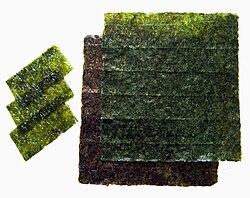Nori

Nori (海苔) je japanski naziv za različite vrste jestivih morskih algi koje spadaju u crvene alge porfira (Porphyra); uključujući najistaknutije vrste P. yezoensis i P. tenera. Gotov proizvod se dobija isušivanjem i skupljanjem algi, sličan proizvodnji papira. Japan, Koreja i Kina su trenutno najveći proizvođači nori algi.
Ranije se pod nazivom nori mislilo na mnogo više vrsta algi nego što je to slučaj danas; pa je tako i alga Hidžiki spadala u tu grupu. Jedan od najranijih opisa alge nori nalazi se u Tajho zakoniku iz 701. godine, gde se spominje njeno oporezivanje. Nori se ranije pripremao u vidu kaše a tek kasnije u toku Edo perioda, u Edo četvrti Asakusa, stvoren je nori u obliku tankih listova koji se i danas tako obranjuje. Ovaj postupak obrade vodi poreklo od japanskog načina pravljenja papira.
Nori se sastoji od 1/3 proteina i 1/3 jestivih vlakana. Sadrži visok postotak joda, karotena, vitamina A, B i C, kao i značajnu količinu kalcijuma i gvožđa. Dok hranjiva vrednost nori alge može da varira, u proseku 100 grama isušenog jaki-nori sadži:
- Proteini - 41.4g
- Masti - 3.7g
- Jestiva vlakna - 36.0g
- Kalcijum - 280mg
- Magnezijum - 300mg
- Kalijum - 2.4mg
- Jod - 6mg
- Cink - 3.6mg
- Gvožđe - 11.4mg
- Vitamin A (β-karoten) - 25mg
- Vitamin E - 4.6mg
- Vitamin K - 390μg
- Vitamin B1 - 690μg
- Vitamin B2 - 2.33mg
- Vitamin B3 - 11.7mg
- Vitamin B6 - 590μg
- Vitamin B12 - 57.6μg
- Vitamin B9 - 1.90μg
- Vitamin B5 - 1.18mg
- Vitamin C - 210mg
Literatura[uredi | uredi izvor]
- Merriam-Webster Dictionary
- Kodansha encyclopedia of Japan, Volume 6. Kōdansha. 1983. ISBN 978-0-87011-620-9. стр. 37. "The word nori is used in Japan both as a general term for seaweed and as a name for a species of red algae (Porphyra tenera) that is commonly used as a foodstuff and is also known as asakusa- nori."
- Ragan, Mark A., ed (1987). Twelfth International Seaweed Symposium: proceedings of the Twelfth International Seaweed Symposium : held in Sao Paulo, Brazil, July 27-August 1, W. Junk. 1986. ISBN 978-90-6193-644-2. стр. 5.. "In the Law of Taiho (AD 701) which was established by the Emperor at that time, marine algae such as Laminaria, Undaria and its sporophyll, Porphyra and Gelidium are included among marine products which were paid to the Court as tax."
- Nishizawa, Kazutoshi (2002). Seaweeds kaiso: bountiful harvest from the seas : sustenance for health & well being by preventing common life-style related diseases. Japan Seaweed Association. "In the Law of Taiho (AD 701) which was established by the Japanese Fortysecond Emperor (Monmu-Tenno, 697-707) at that time, marine algae such as Laminaria, Undaria and their sporophyll, Porphyra and Geridium were paid to the Court as a tax."
- Hiroshi, Terayama (2003). 和漢古典植物考 (Japanese and Chinese Classical Botany). asaka Shobō. pp. 588. "There is a description "local peoples was drying nori" in Hitachi Province Fudoki (721–721), and also there is a description "nori was harvested" in Izumo Province Fudoki (713–733). These show nori was used as food from ancient times."
- Shimbo, Hiroko (2001). The Japanese kitchen: 250 recipes in a traditional spirit. Harvard Common Press. стр. 128. ISBN [[Посебно:BookSources/978-1-55832-177-9 "Unlike wakame, kombu, and hijiki, which are sold in the form of individual leaves, nori is sold as a sheet made from small, soft, dark brown algae, which have been cultivated in bays and lagoons since the middle of the Edo Era (1600 to 1868). The technique of drying the collected algae on wooden frames was borrowed from famous Japanese paper-making industry."|978-1-55832-177-9 "Unlike wakame, kombu, and hijiki, which are sold in the form of individual leaves, nori is sold as a sheet made from small, soft, dark brown algae, which have been cultivated in bays and lagoons since the middle of the Edo Era (1600 to 1868). The technique of drying the collected algae on wooden frames was borrowed from famous Japanese paper-making industry."}-]] Proverite vrednost parametra
|isbn=: invalid character (pomoć).
